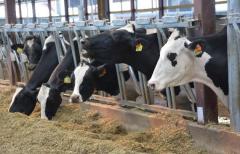Regular Review of Financial Records Trait of Profitable Dairy Herds
Regular Review of Financial Records Trait of Profitable Dairy Herds

For dairy businesses to be profitable and sustainable, their owners must be excellent managers of cattle, crop production, employees/family members, and financial resources. All of these pieces are necessary, and most producers are well versed in managing their crop and cattle resources. Managing financial resources can be more of a challenge for some, as it requires office time to compile and then review numerous categories associated with the income, expenses, assets, and liabilities of a dairy operation. However, finding the time to devote to completing and reviewing these records on a routine schedule throughout the year, not just at tax time or a scheduled visit to the banker, is a necessary management practice. Comparing financials across years also can help one see changes that have occurred, be it positive or negative, and develop a plan to manage one’s operation going forward.
Compare Yearly Income and Expenses
Tax time forces one to finalize the collection of income and expenses for the previous year. Compiling this information for your tax preparer should only be part of this process. Reviewing this information can help determine areas that may allow more total net revenue to be generated going forward.
When reviewing sources of income and expenses, one should calculate these not only on a total farm basis, but also per cwt of milk and per cow. These additional calculations allow one to compare your data to other operations, but, as importantly, allow for comparison of your dairy business between years as the number of cows and total production may change over time. By calculating expenses on a cwt of milk basis, one has a dollar value based on your data regarding the milk price needed to cash flow. Knowing this number is important when evaluating whether and how to use risk management tools related to milk pricing that are available.
To complete this evaluation, one needs to have these data in a format that allows for easy comparison and on-going calculations. Itemizing each of the categories for income and expenses in a spreadsheet or on a piece of paper with multiple columns allows one to alter or add additional calculations and make comparisons not only for this tax year, but also previous tax years. (I have found this very informative and surprising how consistent or inconsistent expenses are from year to year in my personal expenses.)
Pre-paid expenses (feed, seed, fertilizer etc.) need to be credited to the year in which they were used/fed. The same is true for unpaid bills; they need to be associated with the year they are used/fed, not the year in which they are paid. This way you are looking at actual expenses for your operation for the year identified, not those credited to a particular tax year. Interest and depreciation should be noted and accounted for in the calculations, but kept on separate lines from other expenses. One challenge is separating those expenses (and income) that should be charged to another enterprise (i.e. steers, cash grain or other crops) so that the cows do not get charged for them.
Use These Data to Make Management Decisions
Looking at trends in each category of expenses and income over multiple years allows one to see where dollars are consistently being spent and to identify areas of overspending or changes in expenses. This itemized information also can help one see the impact a change, such as increased milk production or adding a few more cows or another enterprise (retaining calves), can have on cash flow. Essentially, this evaluation allows one to integrate the financial aspects with managing dairy cattle, crops, and labor. This evaluation does not occur in one sitting, but over multiple sessions that is on-going throughout the year.
Of course, I would be remiss and quickly corrected by economists and bankers alike, if I did not mention that reviewing income and expenses for a dairy operation is just one component of assessing the profitability of a business. Assets held by the dairy operation need to be accounted for and profitability of any business relates to “owning” assets, not just acquiring these assets. The calculations associated with a balance sheet or net worth statement are the true assessment of profitability of a business and will be the topic of other articles in this series (link article 1 and article 2).
Author: Donna M. Amaral-Phillips
